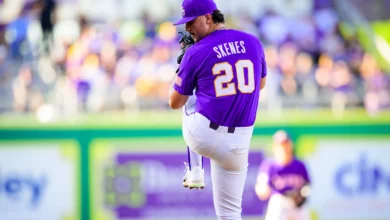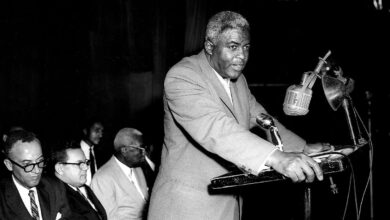His playing career was, to use my dad’s favorite expression, nothing to write home about. At age 20 in 1913, Billy Meyer debuted as a catcher for the Chicago White Sox, batting once and hitting a single. He returned to the majors in 1916, lasting two seasons with the Philadelphia Athletics. For his career, he batted .236/.274/.289 in 113 games.
Failure’s no success at all
On the other hand, Meyer’s major-league managerial career might be worth writing about, but only by one who writes tragedies. In five years at the helm for the Pittsburgh Pirates, his record was 317-452 for a .412 winning percentage. He took over a miserable team that had finished 62-92, good for seventh place in the eight-team National League in 1947. His 1948 Pirates shocked the baseball world, finishing fourth with an 83-71 record. Unfortunately, it was all downhill after that, as his team cratered to a 42-112 last-place finish in 1952. Meyer then resigned, citing health reasons. That 1952 team is thought by some experts to have been the worst team in the history of baseball. They furnished their catcher, Joe Garagiola, with plenty of comic material as he propelled himself to a celebrity career.
Conversely, as a minor-league manager, Meyer had won eight pennants from 1926-1947, mostly in the New York Yankees system. However, as you know, the Yankees weren’t doing too badly during those years. They had no reason to promote Meyer to the big club. Meyer’s search for a major-league managerial gig landed him in Pittsburgh. “I fought for years to get to the big leagues and look what happens to me,” he said upon resigning. “I wish the Pirates luck but I can’t see any success for them in the near future.”
A most kind man
Meyer was beloved by the Pirates’ front-office personnel for his kindness and by sports writers for his candor. Watching his Pirates take infield practice before a 1952 doubleheader in Cincinnati, he confided to Al Abrams, long-time esteemed sports editor of the Pittsburgh Post-Gazette, “Look at that midget infield. Isn’t that a joke? But please, not a word of this until the day I die.” Abrams kept his word and never printed it until an April 2, 1957 column about Meyer’s recent death.
Apparently, Meyer’s nice-guy reputation was important to him. He sued Metro-Goldwyn-Mayer Pictures for “alleged derogatory statements and actions” in actor Paul Douglas’s portrayal of fictional Pirates manager Guffy McGovern, “a very rough and unsavory character,” in the 1951 movie Angles in the Outfield. Even though McGovern wasn’t named after him, Meyer believed the character reflected poorly on him and damaged his reputation. Meyer won his case, paid income taxes on the damages and later sued the government to get the money back. If nothing else, he was litigious.
The mystery
The Pirates have retired nine numbers: players Ralph Kiner (4), Willie Stargell (8), Bill Mazeroski (9), Paul Waner (11), Pie Traynor (20) Roberto Clemente (21) and Honus Wagner (33) and managers Meyer (1) and Danny Murtaugh (40). Eight of these require no explanation. Why Meyer’s number was retired remains a mystery nobody seems able to explain. There is no evidence of a Billy Meyer Day or any type of ceremony to retire the number. The first mention of Meyer’s retired number was in a February 7, 1958 column by Lester J. Biederman of The Pittsburgh Press who, at the bottom of a mishmash of sports news and opinions, wrote simply, “The Pirates have retired Billy Meyer’s uniform No. 1, alongside that of Honus Wagner’s No. 33.”
Theories abound for why Meyer’s number was retired. One attributes it to a clerical error by a Pirates employee when listing the team’s retired numbers. However, there was only one other Pirates retired number at the time. I don’t know which notion is more absurd, that anybody would be assigned such a foolhardy task or that somebody could actually screw it up. Another theory says the number was assumed retired because nobody had worn it for so long after Meyer. This seems ridiculous, too. It’s not as though decades had passed. Others have espoused the theory that the Pirates simply wanted to do something nice for him, since he had been such a nice man during his time in Pittsburgh.
The history
The custom of retiring numbers started in the National Hockey League in 1934, with Ace Bailey of the Toronto Maple Leafs. Bailey played for the Maple Leafs from 1926-34, scoring 111 goals and 81 assists in 316 games. For the 44-game 1928-1929 season, he led the league in goals with 22 and total points with 32, finishing second in voting for the Hart Memorial Trophy. Although he was inducted into the Hockey Hall of Fame in 1975, but for that 1928-1929 season, his statistics indicate he was a good, but not great, player. His career came to a sudden end in 1933 when, on the receiving end of a vicious hit from Boston’s Eddie Shore, he fractured his skull on the ice.
If we can believe the 1954 date most sources give for Meyer’s number retirement, his was the seventh in baseball history. The first six, in order, were Lou Gehrig, Carl Hubbell, Babe Ruth, Mel Ott, Wagner and Joe DiMaggio. Although Ott also managed, it is clear he was honored for his stellar playing career. Thus, Meyer was the first manager in baseball to have his number retired. Furthermore, at that point only three baseball teams had ever retired a number: the Pirates, Yankees and Giants.
After Meyer, there was a smattering of number retirements in baseball. The custom didn’t really catch on until 1972, when eight numbers were retired. Ever since, most years have seen numerous number retirements throughout baseball. It’s a good way to guarantee a sellout crowd once in a while.
So, why Meyer?
So why was Meyer’s number retired? I suppose we’ll never know. I’ll go with the “nice-guy” theory. After all, as we look at the history of retired numbers, it wasn’t customary in baseball at the time. There were no apparent criteria for this honor. There was no widely held notion that it was to be reserved to reward greatness.
By 1965, the Houston Colt 45s hadn’t gotten that memo either. That’s when the 13th number to be retired in baseball happened, that of Jim Umbricht of the Colt 45s. Umbricht was 8-3 with a 2.33 ERA, mostly in relief, in two years with Houston. He had died from melanoma while an active member of the team. His number was retired to honor him after his passing.
The number retirements of Meyer and Umbricht have been criticized unfairly, using hindsight to evaluate them by today’s standards. Those standards didn’t exist in 1954 or 1965. It seems their respective teams wanted to do something nice for a couple of guys who’d gone through tough times. That may have been the case with Bailey, too. What’s wrong with being nice?
Oops!
In my earlier article about the Tacoma Rainiers, I stated the Pawtucket Red Sox were the triple-A affiliate of the Boston Red Sox. I should have used the past tense. I’ve since been informed by a Rhode Island resident reader that the PawSox actually moved to Worcester, Massachusetts in 2021. However, he assures me that driving around Massachusetts remains a deadly proposition.




